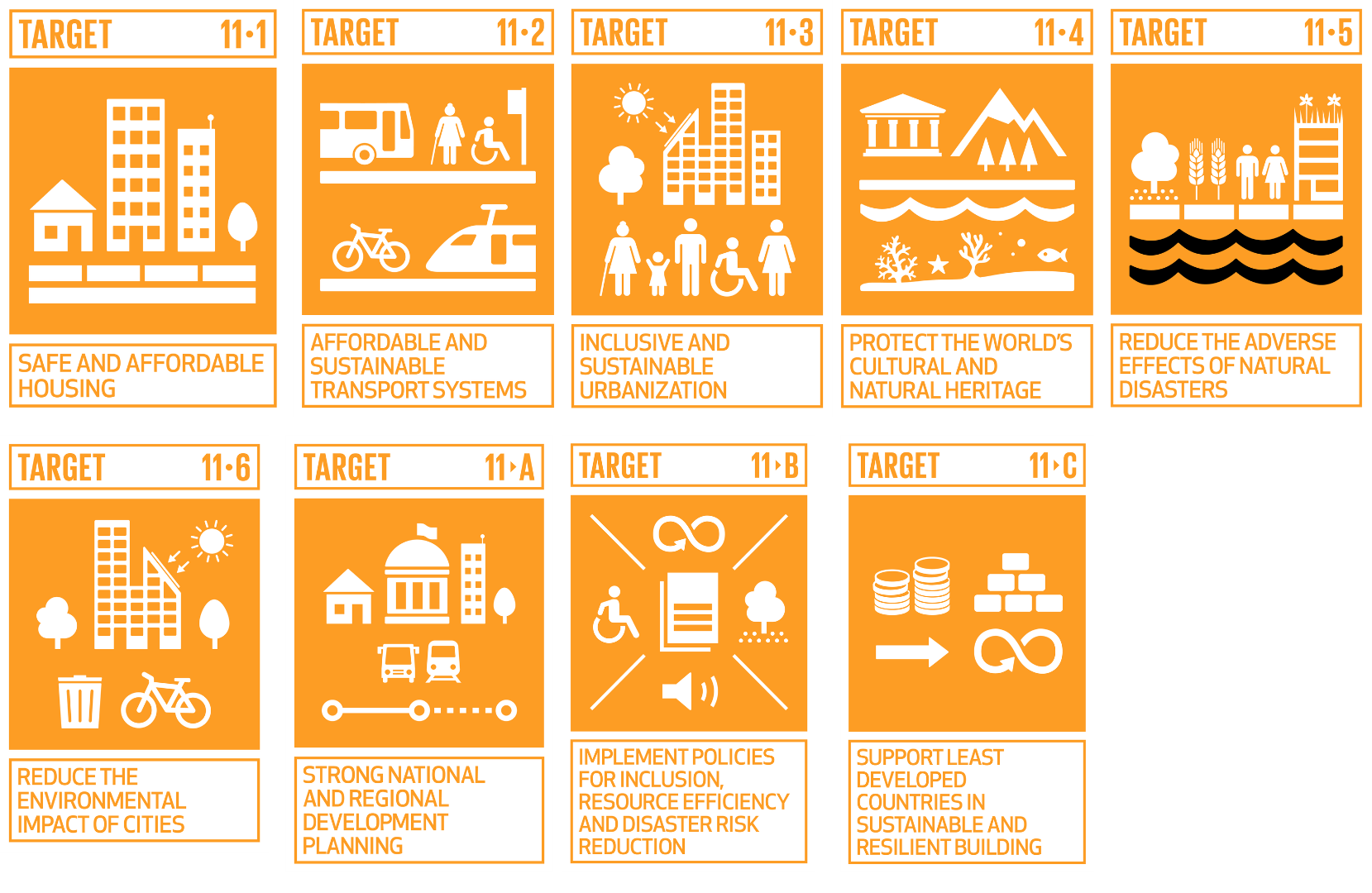SDG 11 - Make cities and human settlements inclusive, safe, resilient and sustainable
Actions for SDG 11
Encourage respect and conservation of natural and cultural heritage ⬇
- Try to avoid pollution of the landscape through structures adapted to the natural environment
- Minimize the light pollution as much as possible
- Broadcast campaigns that respect the preservation of cultural heritage
- Jointly develop and/or participate in a sustainable community that brings together relevant stakeholders through a common and neutral platform to jointly analyze, discuss and act on urban functionality, resilience and sustainable development
- Use technological expertise to help build capacity of building owners to deliver solutions to improve energy efficiency in buildings and enable sound building management practices using good data about a building’s performance
- Reform private sector finance investment strategies to support integrated and sustainable urban development like sustainable urban transport, low-carbon buildings, and resilient infrastructure
Offer products and activities related to natural and cultural heritage ⬇
- Publicly commit to local heritage conservation initiatives
- Feature awareness-raising messages that request respect for local culture and customs
- Celebrate "shows" with linguistic demonstrations of the most spoken languages in the area
- Offer samples of gastronomic heritage in your facilities.
- Exhibit works by local artists
Disseminate local knowledge related to traditions and cultural heritage (tangible and intangible) ⬇
- Provide on-site information on the traditions of your location
- Develop events to spread knowledge about the cultural heritage
- Have a list or catalog of the cultural heritage of the territory available to customers
Collaborate with other local companies and administration to avoid excesses that harm the common good ⬇
- Establish agreements with local transport systems for the transfer of customers/users of your organization
- Establish agreements with local food companies to offer healthy local cuisine
- Distribute information about different attractions of tourist interest to avoid overcrowding at certain locations
- Avoid falling into stereotypes and ensure authenticity when displaying the culture of the destination
- Invest in safe and sustainable infrastructure in the community and or city of operation, including lighting, transportation, alarm systems etc
Support programmes for sustainable mobility and universal accessibility ⬇
- Promote transport on foot, bicycle or similar
- Inform about accessible public transport according to functional diversity
- Facilitate access to public transport
- Have up-to-date and truthful information about transportation services in the territory and to others nearby
- Your facilities comply with the accessibility and mobility requirements and protocols for people with limited mobility
- Collaborate with cities and governments to find solutions to future mobility needs that minimize environmental impact while making transportation safer and more affordable for all
SDG 11 in Canada
Sustainable Homes and buildings ⬇
- Safe and affordable housing is the cornerstone of inclusive and sustainable communities.
- Canada introduced its $40 billion, 10-year National Housing Strategy in 2017 to enable more Canadians to have a place to call home by promoting diverse communities and building housing that is fully integrated—close to transit, work and public services—into the community

The federal government committed $28.7 billion over the next decade in bolstering the capacity, quality, safety and accessibility of public transit infrastructure ⬇
- The $2-billion National Trade Corridors fund will build stronger, more resilient and efficient trade and transportation corridors.
- The Smart Cities Challenge, which launched in the fall of 2017, seeks to encourage all communities to become dynamic, forward thinking and innovative through the adoption of smart cities approaches. Delivering up to a total of $225 million in prizes directly to communities over 10-years, the Smart Cities Challenge represents a change in the way the Government of Canada provides funding to its communities.
- The Government of Canada’s $180 billion, 12-year infrastructure plan addresses persistent challenges to air, water and soil quality to make Canadian communities, including Indigenous communities, more resilient to climate change, natural disasters and extreme weather events.
Preserving Canada’s historical and natural heritage ⬇
- In February 2017, the Government of Canada made a contribution to UNESCO’s Heritage Emergency Fund, reaffirming Canada’s commitment to the protection of cultural heritage and pluralism in armed conflict and other emergencies, and to the leadership role played by UNESCO in responding to such emergencies wherever they occur.
- Tourism is an important economic driver in urban, rural and remote areas. Parks Canada is present in more than 400 Canadian communities and collaborates with partners and stakeholders to promote and preserve Canada’s national parks and historic sites.
- Ontario’s Rouge National Urban Park, for example, comprises natural, cultural and agricultural landscapes that are home to over 1,700 species of plants and animals.
- As well, some of the last operational farms in Canada’s largest urban area, the Greater Toronto Area, rare Carolinian forest ecosystems and human history dating back 10,000 years, including some of Canada’s oldest known Indigenous sites, can be found in the park
Latest Updates/Resources related to SDG 11
Sources
Government of Canada, Canada’s Implementation of the 2030 Agenda for Sustainable Development - Voluntary National Review, 2018
SDG Compass, Learn More About the SDGs, 2015







